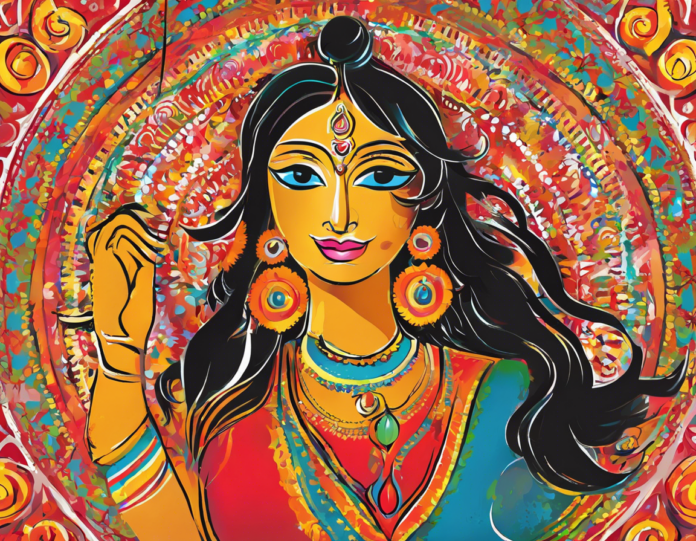Navratri is a Hindu festival celebrated over nine nights in honor of the goddess Durga and her various forms. The festival is observed with different customs and traditions across India and is particularly popular in states like Gujarat, Maharashtra, and West Bengal. One of the most visually striking aspects of Navratri celebrations is the use of vibrant colors. These colors hold deep symbolism and significance, representing different aspects of life, nature, and spirituality.
The Significance of Colors in Navratri:
In Hindu culture, colors are often used to symbolize emotions, virtues, and cosmic elements. Each day of Navratri is associated with a specific color, representing different manifestations of the goddess Durga. These colors are believed to have a profound impact on the worshippers and create a positive atmosphere during the festival.
The Nine Colors of Navratri:
-
Yellow: The first day of Navratri is associated with the color yellow, symbolizing joy and freshness. Yellow is also associated with the planet Mars, signifying courage and valor.
-
Green: The second day is dedicated to the color green, representing prosperity and growth. Green is also linked to the planet Mercury, symbolizing intelligence and communication.
-
Grey: On the third day, devotees wear grey, which symbolizes the power of transformation. Grey is associated with the planet Jupiter, signifying wisdom and knowledge.
-
Orange: The fourth day is marked by the color orange, which represents energy and enthusiasm. Orange is also linked to the planet Venus, symbolizing creativity and beauty.
-
White: White is associated with the fifth day of Navratri and symbolizes purity and peace. It is also linked to the planet Saturn, signifying discipline and focus.
-
Red: The sixth day is dedicated to the color red, representing action and strength. Red is associated with the planet Sun, symbolizing power and vitality.
-
Royal Blue: On the seventh day, devotees wear royal blue, symbolizing divinity and spirituality. Royal blue is linked to the planet Moon, signifying emotions and intuition.
-
Pink: The eighth day is marked by the color pink, representing hope and compassion. Pink is associated with the planet Rahu, symbolizing imagination and intuition.
-
Purple: The final day of Navratri is associated with the color purple, symbolizing peace and creativity. Purple is linked to the planet Ketu, signifying transformation and spirituality.
The Spiritual and Psychological Impact of Colors:
The use of colors during Navratri is not merely a visual spectacle but also has spiritual and psychological significance. Colors are believed to have the power to influence our emotions, thoughts, and energy levels. Wearing specific colors during Navratri is thought to align individuals with the qualities and virtues associated with each day, fostering a sense of harmony and balance.
The Rituals and Traditions of Navratri:
During Navratri, devotees perform rituals such as fasting, praying, and dancing to honor the goddess Durga. In addition to wearing specific colors, many people also decorate their homes and temples with colorful flowers, fabrics, and rangoli designs. These decorations add to the festive atmosphere and create a sense of joy and celebration.
FAQs about Navratri Colors:
Q1: Why are colors significant during Navratri?
A: Colors are believed to represent different aspects of life, nature, and spirituality during Navratri. Each color is associated with a specific quality or virtue that devotees seek to cultivate during the festival.
Q2: What is the symbolism behind wearing different colors on each day of Navratri?
A: Wearing different colors each day is believed to align individuals with the qualities and virtues associated with that particular day, creating a harmonious and balanced spiritual environment.
Q3: How do colors impact our emotions and energy levels during Navratri?
A: Colors are thought to have the power to influence our emotions and energy levels. By wearing specific colors during Navratri, devotees aim to enhance positive qualities and traits associated with those colors.
Q4: What are some ways to incorporate Navratri colors into daily life during the festival?
A: Devotees can incorporate Navratri colors into their daily lives by wearing clothes in the designated colors, decorating their homes with colorful items, and creating rangoli designs using the specific colors of each day.
Q5: Are there specific guidelines for choosing Navratri colors for clothing and decorations?
A: While there are traditional colors associated with each day of Navratri, individuals are encouraged to choose shades of these colors that resonate with them personally. The focus is on embracing the qualities and virtues represented by the colors rather than strict adherence to specific shades.
In conclusion, the vibrant colors of Navratri not only add to the visual splendor of the festival but also carry deep symbolism and significance. By embracing these colors and the qualities they represent, devotees seek to invoke the blessings of the goddess Durga and cultivate virtues such as courage, prosperity, and compassion in their lives..navratritritri








